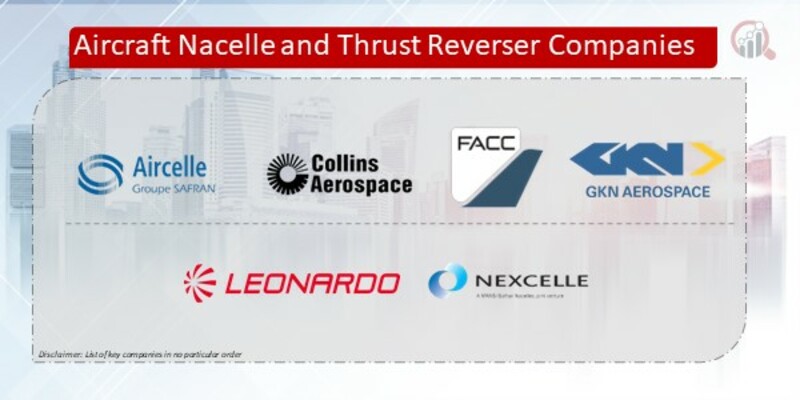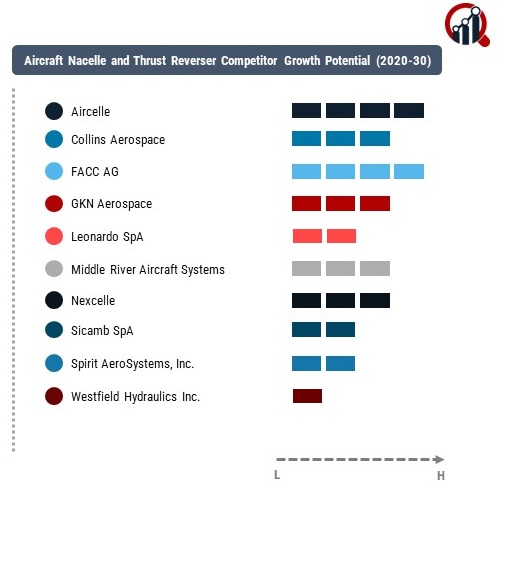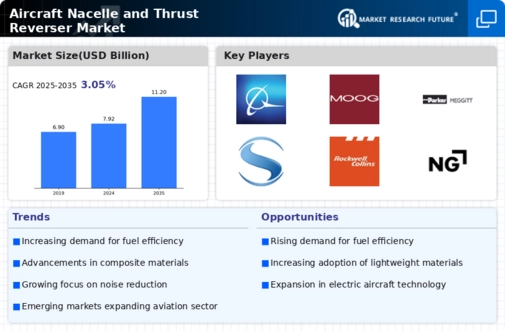Top Industry Leaders in the Aircraft Nacelle and Thrust Reverser Market

Strategies Adopted:
Innovation in Design: Key players focus on designing advanced nacelles and thrust reversers that improve aerodynamic performance, reduce fuel consumption, and enhance aircraft efficiency, thereby attracting customers seeking modern and fuel-efficient aircraft solutions.
Strategic Partnerships: Collaborations with aircraft manufacturers and engine suppliers enable companies to secure long-term contracts, expand market reach, and integrate their nacelle and thrust reverser solutions into various aircraft platforms, driving revenue growth and market share expansion.
Customer-Centric Approach: Adopting a customer-centric approach, companies offer tailored nacelle and thrust reverser solutions that meet specific customer requirements, such as noise reduction, weight optimization, and maintenance cost savings, thereby enhancing customer satisfaction and loyalty.
Focus on Sustainability: Emphasizing environmental sustainability, key players invest in research and development initiatives to develop lightweight materials, eco-friendly coatings, and noise-reducing technologies that align with regulatory requirements and market demand for environmentally friendly aircraft components.
Key Players
Aircelle (a part of Safran SA (France))
Collins Aerospace (a part of United Technologies Corporation (US))
FACC AG (Austria), GKN Aerospace (UK)
Leonardo SpA (Italy)
Middle River Aircraft Systems (a part of GE Aviation (US))
Nexcelle (a MRAS/Safran joint venture (US))
Sicamb SpA (Italy)
Spirit AeroSystems, Inc. (US)
Westfield Hydraulics Inc. (US)
Factors for Market Share Analysis:
Product Portfolio: The breadth and depth of product offerings, including nacelle and thrust reverser solutions for various aircraft types and engine models, influence market share by enabling companies to address diverse customer needs and capture market opportunities across different segments.
Technology Leadership: Companies that demonstrate technological leadership through innovations in materials, design, and manufacturing processes gain a competitive edge, attracting customers seeking cutting-edge solutions that enhance aircraft performance and operational efficiency.
Customer Relationships: Strong relationships with aircraft manufacturers, airlines, and engine suppliers contribute to market share by fostering trust, collaboration, and long-term partnerships, resulting in repeat business and new contract wins.
Manufacturing Capabilities: Robust manufacturing capabilities, including advanced facilities, automation, and supply chain management, enable companies to deliver high-quality nacelle and thrust reverser products on time and within budget, enhancing customer satisfaction and market competitiveness.
New and Emerging Companies:
GKN Fokker Services (Netherlands)
Avio Aero (Italy)
Aernnova Aerospace (Spain)
FACC AG (Austria)
Mitsubishi Heavy Industries Aero Engines, Ltd. (Japan)
Aircelle (France)
UTC Aerospace Systems (US)
Woodward, Inc. (US)
Sonaca Group (Belgium)
Korean Air Aerospace Division (South Korea)
Current Company Investment Trends:
Research and Development: Investments in research and development focus on developing next-generation nacelle and thrust reverser solutions that offer improved performance, efficiency, and environmental sustainability, driving innovation and differentiation in the market.
Strategic Partnerships: Strategic partnerships and collaborations with aircraft manufacturers, engine suppliers, and research institutions enable companies to pool resources, share expertise, and accelerate technology development, strengthening their market position and competitiveness.
Sustainability Initiatives: Increasing investments in sustainability initiatives, such as carbon footprint reduction, waste management, and energy efficiency, align with industry trends and customer preferences for environmentally friendly aircraft components, enhancing companies' brand reputation and market competitiveness.
Market Expansion: Investments in market expansion initiatives, including sales and marketing efforts, distribution channels, and customer support infrastructure, aim to capture new market opportunities, penetrate emerging markets, and increase market share, driving revenue growth and profitability.
Overall Competitive Scenario:
The aircraft nacelle and thrust reverser market is characterized by intense competition among key players, driven by technological innovation, strategic partnerships, and customer-centricity. Factors such as product portfolio, technology leadership, customer relationships, and manufacturing capabilities influence market share dynamics. New and emerging companies contribute to market competitiveness by introducing innovative solutions and challenging










